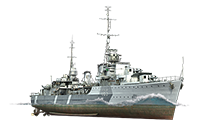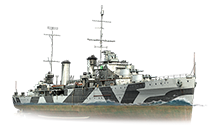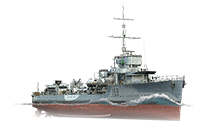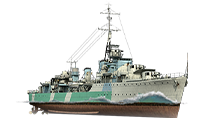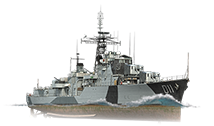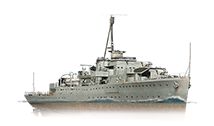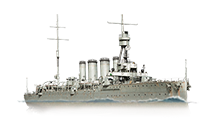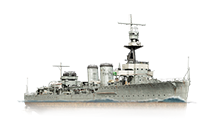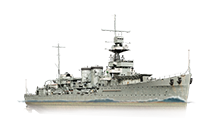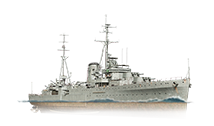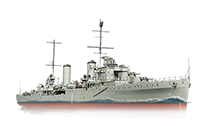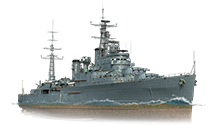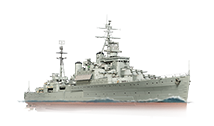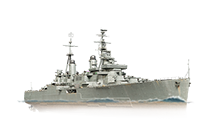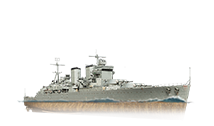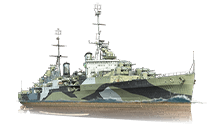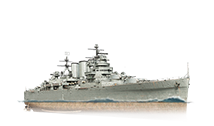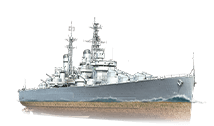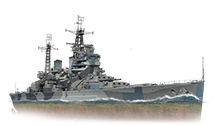Ships of Commonwealth
| Revision as of 21:27, 23 August 2017 | Revision as of 15:32, 3 September 2019 updated commonwealth flag filename | |||
18 intermediate revisions by 5 users not shown | ||||
| Line 1: | Line 1: | |||
| {{AnnoWiki | {{AnnoWiki | |||
| |icon= | |icon= | |||
| ? | |content=[[File:Wows flag Commonwealth. | + | |content=[[File:Wows flag Commonwealth.png|frameless|left|link=]]The "Commonwealth of Nations" was born in the early twentieth century during the waning years of the British Empire. Officially formed in December 1931 via the Statute of Westminster, the original seven member states were the United Kingdom, Australia, Canada, New Zealand, South Africa, Ireland, and Newfoundland. Today, it is made up of 52 sovereign states that span the globe, and currently includes nations that had no previous political or economic ties to the United Kingdom or the British Empire. | |
| ? | }}{{#vardefine:cur_nation|commonwealth}}__NOTOC__[[Category:Ships by nation]] | + | ||
| + | ||||
| + | Several of the various nation-states that comprise the Commonwealth deploy their own military forces. Collectively, they are represented in World of Warships under a single flag, but each navy has its own history and traditions.<br> | |||
| + | ---- | |||
| + | [[File:Wows flag Canada.png|68px|frameless|left|link=]][[Image:Ship_PUSD507_Haida.png|frame|right|link=Ship:Haida|HMCS ''Haida'', Tier VII destroyer]]At the beginning of the twentieth century, the British Empire faced a unique dilemma: the challenge of protecting its many dominions across the world. In the case of the Dominion of Canada, there were two easy solutions: either provide the Royal Navy the resources to protects borders of the Dominion, or take the necessary steps to allow Canada to provide for her own defense. The latter path was chosen, and soon the government put forth a Naval Service Bill organizing a permanent and volunteer force, as well founding as a naval college to train future personnel. Thus, in 1910 the Naval Service of Canada was born; it was later designated the '''Royal Canadian Navy (RCN)''' by King George V on 29 August 1911. | |||
| + | ||||
| + | ||||
| + | The nucleus of the nascent navy came in the shape of two cruisers: HMCS ''Rainbow'' and HMCS ''Niobe'', both seeing service primarily as training vessels. Despite government contention on the logistics and practicality of fielding a navy, the citizens of Canada were supportive of the institution and bolstered the manpower of the volunteer reserve forces (RNCVR). | |||
| + | ||||
| + | By the start of the First World War, the RCN had grown to four cruisers and two submarines. This rather small force spent the majority of the conflict patrolling both coastlines of North America, with most of these assets being deemed unfit for service before the war’s end. The lack of growth of the Navy was largely attributed to the decision by the Canadian government to allow citizens to choose whether they wished to serve with the Royal Canadian Navy or the British equivalent; many chose to serve in the latter. | |||
| + | ||||
| + | The end of World War I saw a reduction of manpower plus a transition to conducting civilian duties, with its handful of destroyers and single cruiser. On the other hand, enthusiasm in the RNCVR stayed strong and continued to grow through the interwar years. By the 1930's, the RCN was slowly seeing new life breathed into it via the acquisition of two new destroyers built in England – the first ships purpose-built for the RCN. Further investment in the service was spurred on by rising tensions and aggression in Europe and Asia; more destroyers and training vessels were acquired. | |||
| + | ||||
| + | The events of the Second World War saw an explosion of growth for the Royal Canadian Navy; ships were simultaneously produced at home and acquired from abroad, with new recruits drawing in from all across the country. The Navy primarily operated in the North Atlantic and was solely responsible for the oversight of the entire Northwest Theater of operations. The RCN fulfilled two primary functions: convoy protection and submarine hunting. During six years of active combat duty, the RCN proved its potential through the destruction or capture of twenty-seven (27) German submarines and forty-two (42) Axis ships. Even more impressive was the fact that the Navy successfully escorted over 25,000 convoy crossings, delivery nearly 182,000,000 tons worth of men and materials critical for the war effort from North America to the United Kingdom. Tragically, this did come at the cost of twenty-four (24) vessels and nearly 2,000 personnel. | |||
| + | ||||
| + | By the end of World War II, the RCN had transformed from an inexperienced service to a formidable force; it was the third-largest navy in the entire world, despite consisting predominantly of destroyers. None could question the diligence displayed by the personnel of the RCN; years of submarine hunting had shaped the service into masters of anti-submarine warfare. That experience would come in handy during the Cold War while tracking the Soviet submarines. To this day, the proud traditions of the RCN adhere to the prestige forged by their founders and predecessors. | |||
| + | ---- | |||
| + | [[File:Wows flag Australia.png|68px|frameless|left|link=]][[Image:Ship_PUSC506_Perth_1942.png|frame|right|link=Ship:Perth|HMAS ''Perth'', Tier VI cruiser]]With the vast majority of its population spread along the long coastlines of the country, Australia relied upon detached units from the Royal Navy to provide naval defense for more than a century. This arrangement remained the status quo until 1909, when talks began of a dedicated naval unit to be deployed to Australian waters. It was decided between the British Admiralty and the Australian Government that Australia would purchase a "fleet unit" consisting of six destroyers, three cruisers, three submarines, various auxiliaries, and a battlecruiser. The first two ships, HMAS ''Yarra'' and HMAS ''Parramatta'', reached Australian waters in November 1910, and on 10 July 1911 King George V granted the title of '''Royal Australian Navy (RAN)''' to the Commonwealth Naval Forces. By 1913, the completed Australian fleet — led by battlecruiser HMAS ''Australia'' — entered Sydney Harbour for the first time. | |||
| + | ||||
| + | ||||
| + | The RAN served on the frontlines of World War I, supporting Australian landings in the invasion of the German New Guinea colonies and attacking the Ottoman Navy in the Sea of Marmora during the Gallipoli campaign. HMAS ''Sydney'' faced off alone against SMS ''[[Emden]]'' in the middle of the Indian Ocean and won — earning the RAN's first victory at sea — while HMAS ''Australia'' was later involved in the Battle of Jutland. After the war, the RAN — like most other navies around the world — was forced to make changes as a result of the Washington Naval Treaty of 1922. They had to scrap their only battlecruiser as a result of the treaty, but gained several pre-war submarines and destroyers. | |||
| + | ||||
| + | During the inter-war period, older ships were sold for scrap while newer heavy cruisers, light cruisers, submarines, destroyers, and a seaplane carrier found their way into RAN service. Hampered by the inter-war disarmament policies due to shifting economic and political situations, the RAN rose once again to fight in World War II. Throughout 1940, the RAN distinguished itself in the Mediterranean with the famous destroyers of the "Scrap Iron Flotilla". RAN units returned to defend the Australian homeland when war broke out in the Pacific and enemy ships prowled Australian waters, fighting against the encroaching Empire of Japan as close to home as the Coral Sea. | |||
| + | ||||
| + | Since the end of the Second World War, the Royal Australian Navy has served in operations from the Korean Theater to East Timor, focusing on protecting Australia’s interests in the southwestern Pacific region and peacekeeping around the globe with a 50-strong fleet of modern destroyers, frigates, submarines, and auxiliaries. | |||
| + | ---- | |||
| + | [[File:Wows flag New Zealand.png|68px|frameless|left|link=]]Much like their neighbors across the Tasman Sea, New Zealand was protected by the [[Ship:Ships of U.K.|Royal Navy]] from its founding well into the twentieth century. The residents of New Zealand took an active role in contributing to their own defense early on, providing spar torpedo boats to their assigned division of the Royal Navy late in the nineteenth century as well as fully funding the ''Indefatigable''-class battlecruiser HMS ''New Zealand'' commissioned into His Majesty's service in 1911. ''New Zealand'' served throughout the duration of World War I, seeing action at Heligoland Blight, Dogger Bank, and in the Battle of Jutland. | |||
| + | ||||
| + | ||||
| + | The "New Zealand Naval Forces" were formally organized as a part of the Naval Defence Act of 1913, and referred to as the New Zealand Division of the Royal Navy from 1921 onwards. The New Zealand Division was largely comprised of cruisers and lighter units, including HMS ''[[Leander]]'', HMS ''Achilles'', and a pair of ''[[Danae]]''-class cruisers. With the outbreak of World War II in September 1939, New Zealand joined the rest of the British Empire in declaring war on Germany. Recognizing that the existing New Zealand Division was already largely independent and self-sufficient, King George VI christened it the '''Royal New Zealand Navy (RNZN)''' on 1 October 1941. The RNZN contributed ships and men in several key theaters of operations during the course of the war, seeing action — and suffering losses — in both the Atlantic and Pacific Oceans as well as the Mediterranean Sea. | |||
| + | ||||
| + | Having grown to nearly sixty ships by August 1945, the RNZN was drastically scaled down in size following the conclusion of the Second World War. Nevertheless, RNZN forces continued to participate in combat operations in conjunction with the United Nations by contributing ships to both the Korean War and intervention efforts in East Timor. The modern RNZN has fewer than a dozen ships in service: a mix of frigates, coastal patrol vessels, and other light craft that patrol home waters and ensure the sovereignty and safety of their homeland. | |||
| + | }} | |||
| + | {{#vardefine:cur_nation|commonwealth}}__NOTOC__[[Category:Ships by nation]] | |||
| {{#vardefine:list|{{WoWs Class||list}}}}{{#vardefine:i|0}}{{#while:|{{#if:{{#explode:{{#var:list}}|;|{{#var:i}}}}|true}}| | {{#vardefine:list|{{WoWs Class||list}}}}{{#vardefine:i|0}}{{#while:|{{#if:{{#explode:{{#var:list}}|;|{{#var:i}}}}|true}}| | |||
| {{#vardefine:cur_class|{{#explode:{{#var:list}}|;|{{#var:i}}}}}}{{#if:{{WoWs_ShipsList|{{#var:cur_nation}}|{{#var:cur_class}}|||text}}|<div class="wot-frame-1"><h2>{{WoWs Class|{{#var:cur_class}}|bm}}</h2> | {{#vardefine:cur_class|{{#explode:{{#var:list}}|;|{{#var:i}}}}}}{{#if:{{WoWs_ShipsList|{{#var:cur_nation}}|{{#var:cur_class}}|||text}}|<div class="wot-frame-1"><h2>{{WoWs Class|{{#var:cur_class}}|bm}}</h2> | |||
| {{WoWs_ShipsList|{{#var:cur_nation}}|{{#var:cur_class}}|||icons}}</div>}}{{#vardefine:i|{{#expr:{{#var:i}}+1}}}}}} | {{WoWs_ShipsList|{{#var:cur_nation}}|{{#var:cur_class}}|||icons}}</div>}}{{#vardefine:i|{{#expr:{{#var:i}}+1}}}}}} | |||
Revision as of 15:32, 3 September 2019

Several of the various nation-states that comprise the Commonwealth deploy their own military forces. Collectively, they are represented in World of Warships under a single flag, but each navy has its own history and traditions.
The nucleus of the nascent navy came in the shape of two cruisers: HMCS Rainbow and HMCS Niobe, both seeing service primarily as training vessels. Despite government contention on the logistics and practicality of fielding a navy, the citizens of Canada were supportive of the institution and bolstered the manpower of the volunteer reserve forces (RNCVR).
By the start of the First World War, the RCN had grown to four cruisers and two submarines. This rather small force spent the majority of the conflict patrolling both coastlines of North America, with most of these assets being deemed unfit for service before the war’s end. The lack of growth of the Navy was largely attributed to the decision by the Canadian government to allow citizens to choose whether they wished to serve with the Royal Canadian Navy or the British equivalent; many chose to serve in the latter.
The end of World War I saw a reduction of manpower plus a transition to conducting civilian duties, with its handful of destroyers and single cruiser. On the other hand, enthusiasm in the RNCVR stayed strong and continued to grow through the interwar years. By the 1930's, the RCN was slowly seeing new life breathed into it via the acquisition of two new destroyers built in England – the first ships purpose-built for the RCN. Further investment in the service was spurred on by rising tensions and aggression in Europe and Asia; more destroyers and training vessels were acquired.
The events of the Second World War saw an explosion of growth for the Royal Canadian Navy; ships were simultaneously produced at home and acquired from abroad, with new recruits drawing in from all across the country. The Navy primarily operated in the North Atlantic and was solely responsible for the oversight of the entire Northwest Theater of operations. The RCN fulfilled two primary functions: convoy protection and submarine hunting. During six years of active combat duty, the RCN proved its potential through the destruction or capture of twenty-seven (27) German submarines and forty-two (42) Axis ships. Even more impressive was the fact that the Navy successfully escorted over 25,000 convoy crossings, delivery nearly 182,000,000 tons worth of men and materials critical for the war effort from North America to the United Kingdom. Tragically, this did come at the cost of twenty-four (24) vessels and nearly 2,000 personnel.
By the end of World War II, the RCN had transformed from an inexperienced service to a formidable force; it was the third-largest navy in the entire world, despite consisting predominantly of destroyers. None could question the diligence displayed by the personnel of the RCN; years of submarine hunting had shaped the service into masters of anti-submarine warfare. That experience would come in handy during the Cold War while tracking the Soviet submarines. To this day, the proud traditions of the RCN adhere to the prestige forged by their founders and predecessors.
The RAN served on the frontlines of World War I, supporting Australian landings in the invasion of the German New Guinea colonies and attacking the Ottoman Navy in the Sea of Marmora during the Gallipoli campaign. HMAS Sydney faced off alone against SMS Emden in the middle of the Indian Ocean and won — earning the RAN's first victory at sea — while HMAS Australia was later involved in the Battle of Jutland. After the war, the RAN — like most other navies around the world — was forced to make changes as a result of the Washington Naval Treaty of 1922. They had to scrap their only battlecruiser as a result of the treaty, but gained several pre-war submarines and destroyers.
During the inter-war period, older ships were sold for scrap while newer heavy cruisers, light cruisers, submarines, destroyers, and a seaplane carrier found their way into RAN service. Hampered by the inter-war disarmament policies due to shifting economic and political situations, the RAN rose once again to fight in World War II. Throughout 1940, the RAN distinguished itself in the Mediterranean with the famous destroyers of the "Scrap Iron Flotilla". RAN units returned to defend the Australian homeland when war broke out in the Pacific and enemy ships prowled Australian waters, fighting against the encroaching Empire of Japan as close to home as the Coral Sea.
Since the end of the Second World War, the Royal Australian Navy has served in operations from the Korean Theater to East Timor, focusing on protecting Australia’s interests in the southwestern Pacific region and peacekeeping around the globe with a 50-strong fleet of modern destroyers, frigates, submarines, and auxiliaries.
The "New Zealand Naval Forces" were formally organized as a part of the Naval Defence Act of 1913, and referred to as the New Zealand Division of the Royal Navy from 1921 onwards. The New Zealand Division was largely comprised of cruisers and lighter units, including HMS Leander, HMS Achilles, and a pair of Danae-class cruisers. With the outbreak of World War II in September 1939, New Zealand joined the rest of the British Empire in declaring war on Germany. Recognizing that the existing New Zealand Division was already largely independent and self-sufficient, King George VI christened it the Royal New Zealand Navy (RNZN) on 1 October 1941. The RNZN contributed ships and men in several key theaters of operations during the course of the war, seeing action — and suffering losses — in both the Atlantic and Pacific Oceans as well as the Mediterranean Sea.
